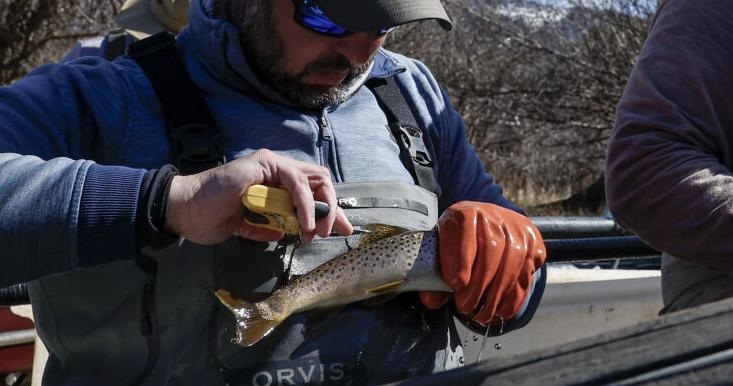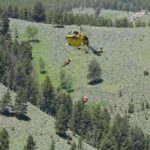A significant uproar occurred last year – akin to a hearty brown trout chasing a salmonfly. The commotion and concern revolved around the decline in trout populations in the renowned Big Hole River since 2011.
In May 2023, over 30 fishing outfitters and guides in Montana urged Gov. Greg Gianforte to take quick action in utilizing state resources to investigate the reasons behind the decreasing trout populations in the river.
After more than two months, Gianforte organized a roundtable discussion in Wise River which involved fishing guides, irrigators, agriculture producers, and biologists. The majority of attendees at the community center were people with agricultural interests.
Recently, Gianforte revisited the Wise River area to receive an update from Jim Olsen, a fisheries biologist for Montana Fish, Wildlife & Parks responsible for the Big Hole River. FWP Director Dustin Temple was also present.
People are also reading…
The update provided both good and mixed news. A press release from the governor’s office emphasized the positive aspects.
The positive news highlighted the increase in juvenile fish observed during electrofishing sampling conducted this spring by Olsen and his team, indicating enhanced recruitment of young fish that could grow into larger specimens.
The less optimistic news was the below-average numbers of brown and rainbow trout in all four sampled sections of the river. In certain sections like Hogback and Pennington, the rainbow trout numbers had decreased either from the previous year’s sampling or from 2021.
For instance, the Melrose section of the river estimated 506 brown trout per mile in 2024, an improvement from the 2023 estimate of 324, but still below the long-term average of 908 per mile for that stretch.
In the Jerry Creek section, the brown trout count was 710 per mile in 2024, the highest since 2015 and an increase from 422 in 2023, yet falling short of the long-term average of 749 per mile.
Rainbow trout numbers in the Jerry Creek section improved from 498 per mile in 2023 to 779 per mile in 2024, but still below the long-term average of 1,606 per mile.
In the Hogback section, rainbow trout were estimated at 268 per mile and brown trout at 722 per mile. While rainbow trout numbers slightly decreased from 2023, the brown trout estimates more than doubled. The long-term averages for this section are 473 rainbow trout and 920 brown trout per mile.
Olsen credited favorable water levels in 2023 for aiding the survival of juvenile trout, as the population increase mainly consisted of 2-year-old fish.
“Although trout populations still lag behind the long-term average, this year’s estimates are promising,” Olsen stated earlier this year.
Remaining Cautious
Wade Fellin, an outfitter, and co-owner of the Big Hole Lodge, as well as a co-founder of Save Wild Trout, reacted to the numbers.
“While seeing incremental growth in wild trout populations is a reason to celebrate, we must remain cautious until we see sustained improvement,” Fellin remarked. “FWP biologists have begun critical studies to determine the factors affecting trout populations, but enhancing the health of waterways requires a collaborative effort. Robust wild trout populations depend on biological, physical, and chemical balance to flourish.”
Fellin highlighted persistent pollution above acceptable levels in the Big Hole River and other blue-ribbon waterways, combined with rising temperatures due to climate change, creating an unsustainable environment for fish health.
“Montana needs to address these underlying issues to protect these rivers,” Fellin emphasized. “Save Wild Trout and the Big Hole River Foundation have been collecting crucial water data to safeguard these water bodies.”
The Big Hole River Foundation has been monitoring water quality on the Big Hole for several years, with approval from the Montana Department of Environmental Quality in 2020 for their sampling and analysis plan.
Brian Wheeler, the executive director of the foundation, has been actively collecting water samples along the Big Hole, focusing on parameters like temperature, sediment, nutrients, and heavy metals to assess pollution levels.
“Dissolved oxygen is crucial for aquatic life and, like nutrients, has recently been studied by the Big Hole River Foundation and Save Wild Trout to ensure the health of fish habitats,” Wheeler added.
Concerns About Disease
Olsen presented data on fish numbers and health during a meeting of the Big Hole Watershed Committee in Divide on May 15.
In recent years, observers have documented fungus and head lesions on trout in the Big Hole, with Olsen mentioning that the fungus is common. However, the condition on the head remains a mystery with ongoing research efforts.
Olsen stressed that maintaining a steady flow of water, particularly cold water, is essential for a healthy trout population.
During low-water years, like the anticipated 2024, tensions may arise between ranchers irrigating hayfields and outfitters relying on summer tourism.
Monitoring Water Levels
The Natural Resources Conservation Service predicts that the Jefferson River Basin will experience 50% to 60% of normal streamflow through July.
FWP may close river sections during low flows and high temperatures to protect stressed fish from angling pressure.
Last year, concerns about low flows and high temperatures impacting trout populations were raised, leading to continued research efforts in the Big Hole, Beaverhead, and Ruby rivers.
Anglers reporting tagged fish this spring can aid researchers in monitoring fish health and movement, potentially qualifying for rewards.
Response to Criticism
Some outfitters and guides criticized the negative publicity related to declining trout populations last year, stating that fishing conditions were generally favorable in 2023.
Shaun Jeszenka, owner of Frontier Anglers, mentioned that the negative publicity had created an overly pessimistic view of fishing conditions in the Jefferson River Basin. Recent fishing experiences have reflected the improved population estimates.





